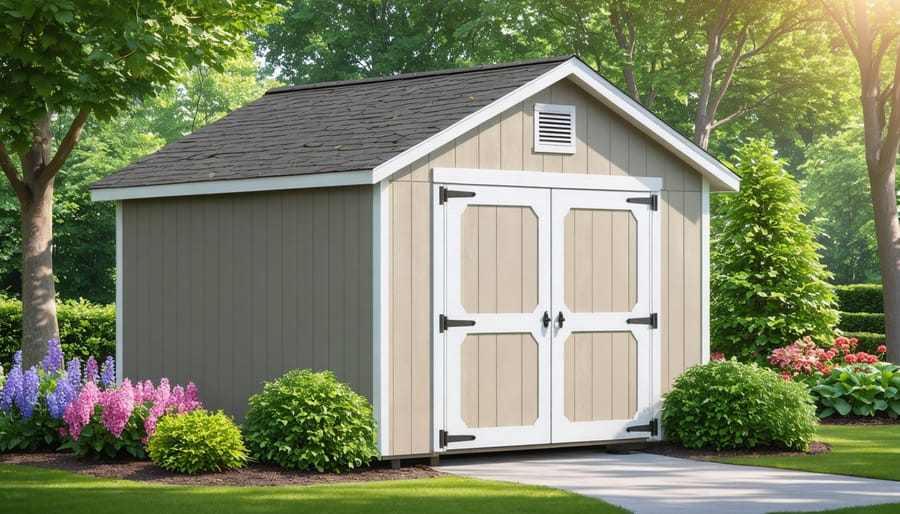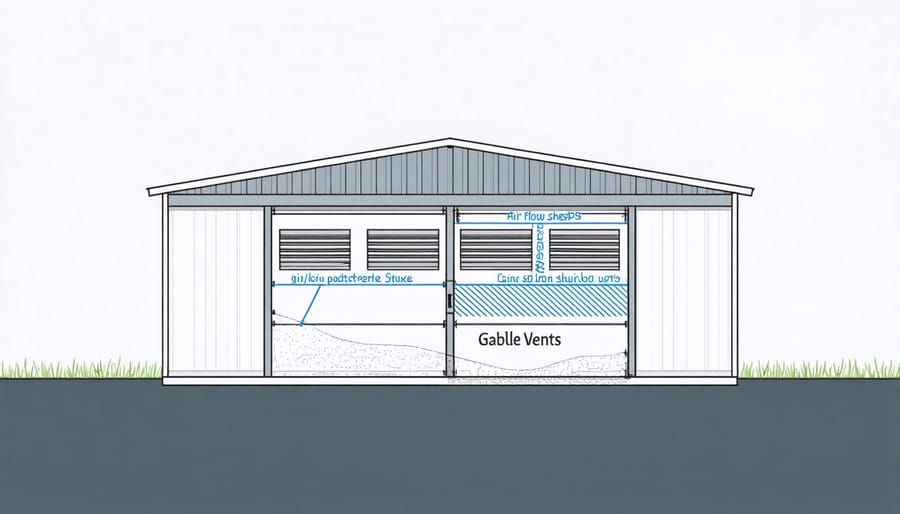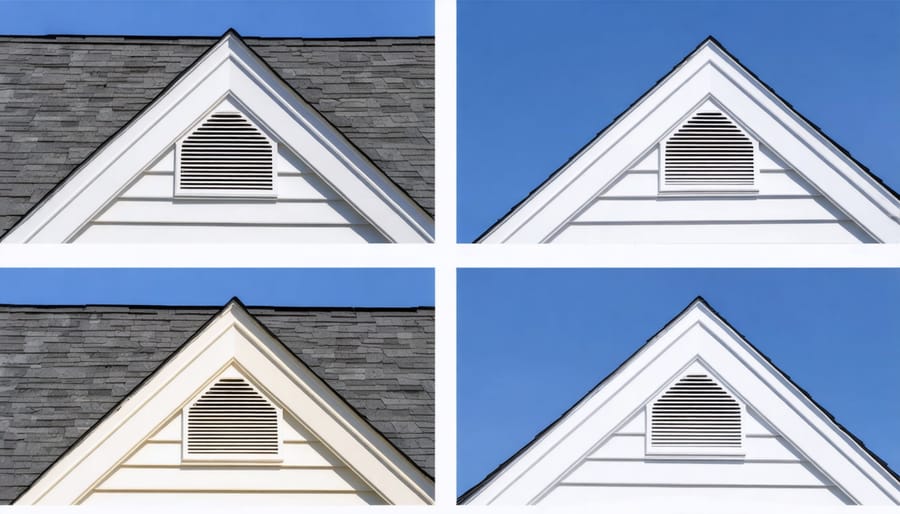Perfect Shed Ventilation: Why Your Gable Vent Makes All the Difference

Transform your shed’s climate control with a properly installed gable vent – the cornerstone of proper shed ventilation. These triangular vents, strategically placed at the peaks of your shed’s end walls, create essential airflow that prevents moisture damage, reduces heat buildup, and extends your storage structure’s lifespan. Beyond protecting valuable tools and equipment, gable vents add architectural character while maintaining optimal temperature control throughout changing seasons. Whether you’re building a new shed or upgrading an existing one, understanding gable vent installation and placement is crucial for creating a healthy, moisture-free environment that preserves both your shed and its contents. This practical guide explores everything from sizing requirements to installation techniques, helping you make informed decisions about ventilating your outdoor storage space effectively.
What Is a Gable Shed Vent?
Components and Design
A gable shed vent typically consists of several key components working together to ensure proper airflow. The main frame, usually made of durable aluminum, vinyl, or wood, forms the outer structure and mounts directly to your shed’s gable wall. Inside this frame sits a sturdy mesh screen that keeps out insects and debris while allowing air to flow freely.
Most gable vents feature louvers – angled slats that direct airflow and provide protection against rain. These louvers can be fixed or adjustable, giving you control over ventilation levels. The vent’s trim piece creates a clean, finished look around the edges and helps ensure a weather-tight seal.
Common design styles include classic rectangular vents, which suit most traditional shed designs, and octagonal or round vents that add architectural interest. Many homeowners choose decorative options with cross-hatched patterns or Victorian-inspired designs to enhance their shed’s appearance. Some modern vents come with built-in dampers that can be closed during severe weather.
For larger sheds, combination designs incorporating multiple smaller vents or ridge vents alongside gable vents are popular choices, offering enhanced ventilation capacity while maintaining aesthetic appeal.

How Gable Vents Work
Gable vents work by harnessing the natural principles of air movement and thermal dynamics. As warm air rises, it creates a continuous flow that helps regulate your shed’s temperature and moisture levels. During warm weather, hot air naturally accumulates near your shed’s roof. The gable vent allows this heated air to escape while drawing in cooler air through lower vents or gaps, creating a natural chimney effect.
This ventilation system is particularly effective because it doesn’t require any power or moving parts. When properly positioned, gable vents take advantage of cross-breezes, which enhance the air exchange process. The warm air escaping through the upper vent creates negative pressure, pulling fresh air in through lower openings.
In winter months, gable vents continue to work effectively by removing excess moisture that could otherwise lead to mold growth or wood rot. The constant air movement helps keep building materials dry and prevents condensation from forming on your stored items.
To maximize efficiency, gable vents should be installed on opposite ends of your shed. This placement ensures optimal airflow and prevents dead spots where stagnant air could collect. The size of your vents should be proportional to your shed’s square footage – generally, you’ll want about one square foot of vent space for every 300 square feet of floor area.

Benefits of Installing Gable Vents
Installing gable vents in your shed offers numerous advantages that make it a worthwhile investment for any storage structure. One of the most significant benefits is effective moisture control in sheds, which helps prevent the growth of mold and mildew that can damage your stored items.
During hot summer months, gable vents create a natural airflow system that helps regulate temperature inside your shed. As warm air rises and exits through the upper vent, it draws in cooler air through the lower vent, creating a continuous circulation that keeps your shed comfortable and your belongings protected. This natural ventilation system is especially beneficial for storing temperature-sensitive items like garden chemicals, paints, or power tools.
The temperature regulation provided by gable vents also helps extend the life of your shed’s structural components. By reducing heat buildup in the attic space, you’ll experience less warping of wooden materials and increased longevity of roofing materials. Many shed owners report that their properly ventilated sheds maintain their integrity much longer than unventilated ones.
Another fantastic benefit is the money-saving aspect of gable vents. Unlike powered ventilation systems, gable vents work without electricity, making them a cost-effective solution for maintaining proper airflow. They require minimal maintenance once installed and can last for years with occasional cleaning.
Gable vents also add aesthetic value to your shed, offering a finishing touch that complements various architectural styles. Available in different shapes, sizes, and materials, they can enhance your shed’s appearance while serving their practical purpose.
For those storing seasonal items, gable vents help maintain consistent conditions throughout the year. Whether it’s holiday decorations, camping gear, or gardening equipment, proper ventilation ensures your belongings remain in good condition, ready for use when you need them.

Installation Guide
Tools and Materials Needed
Before installing ventilation openings, gather these essential tools and materials:
Tools:
– Power drill with drill bits
– Jigsaw or reciprocating saw
– Measuring tape
– Pencil or marker
– Level
– Safety glasses
– Work gloves
– Dust mask
– Ladder or sturdy platform
Materials:
– Gable vent (sized appropriately for your shed)
– Exterior-grade caulk and caulk gun
– Weather stripping
– Exterior screws
– Paint or finish (matching your shed)
– Flashing (if needed)
– Wire mesh or hardware cloth (for pest prevention)
– Plywood or lumber for framing (if required)
Keep all materials within easy reach when working on your shed to ensure a smooth installation process.
Maintenance Tips
Regular maintenance of your gable shed vent is essential for optimal performance and longevity. Start by inspecting your vents every spring and fall, looking for signs of damage, debris buildup, or pest intrusion. Use a soft brush or vacuum to remove dust, cobwebs, and leaves that may obstruct airflow. Pay special attention to the vent screens, ensuring they remain intact to prevent unwanted critters from entering your shed.
Check the vent louvers or flaps for smooth operation if your model includes these features. Apply a light lubricant to any moving parts if they become stiff or squeaky. During your inspection, look for signs of water damage or rust around the vent frame, as these issues should be addressed promptly to prevent deterioration.
If you notice any damaged screens or weather stripping, replace them immediately to maintain proper ventilation and protection. Consider cleaning the vent’s exterior with a mild soap solution annually to prevent dirt accumulation and maintain its appearance. Finally, ensure that nearby vegetation is trimmed back to prevent debris from collecting around the vent and impeding its function.
Proper ventilation through gable shed vents is essential for maintaining a healthy, long-lasting storage space. These simple yet effective components help regulate temperature, prevent moisture buildup, and protect your valuable belongings from potential damage. By ensuring proper installation and regular maintenance of your gable vents, you’ll create an optimal environment that extends the life of both your shed and its contents. Remember that while DIY installation is possible, seeking professional help for complex setups can save time and prevent future issues. Whether you’re building a new shed or upgrading an existing one, investing in quality gable vents is a smart decision that will pay dividends in the long run through better air circulation and reduced maintenance needs.

